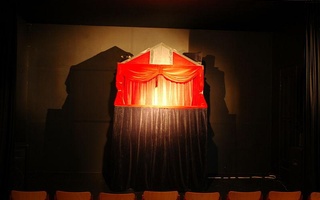
Hyperion Shakespeare Company’s production of “The Seven Deadly Sins of Shakespeare,” which ran in the Adams House Pool Theatre this weekend, featured an engaging cast who combined thoughtful acting with entertainment. Although the storylines of the scenes seemed vague at times, the performance was a compelling look at the foibles of human nature.
Many contemporary plays can be described, in the words of Maria of “Twelfth Night,” as “improbable fiction.” But despite Shakespeare’s often fantastical flourishes, his works have always captured certain human truths. Thanks to this, “The Seven Deadly Sins of Shakespeare,” which ran this weekend at the Adams House Pool Theatre, manages to strike the chords of human folly’s universality using excerpts from the Bard’s plays, allowing the production to resonate, despite its occasional incoherence.
The performance, directed by Sam L. Linden ’10 and put on by the Hyperion Shakespeare Company at Harvard, consists of nine scenes describing the seven deadly sins as manifested in various works of William Shakespeare. Its characters range from tortured to downright oblivious, and all of them find themselves victims of a particular fatal flaw. One can laugh and even sympathize with them, but would certainly never want to become them, though it is always clear how easily one could.
The Adams Pool Theater, with its minimalist décor, is a fitting setting for the show. The lack of scenery or adornment forces the audience to focus only on the characters and the impassioned speeches they are delivering. The setting becomes irrelevant as it becomes clear that people of any time or place could become victims of the seven sins. The lighting remains constant, and the lack of dimming between scenes lends a sense of continuity to the show.
While the acts, which collage extracts of Shakespeare’s plays to fit an overarching theme, connect well aesthetically, the content overall is fragmented. And though the idea of compiling scenes to describe the time-old notion of the “seven sins” is inspired, the execution doesn’t fulfill the concept’s potential. The show is lively and entertaining, but only one of its plot lines is fully resolved. The continuation of the “pride” storyline—which appears in three different scenes—is the only to work well. Perhaps developing the other sins a little further would have made the play more memorable.
Nevertheless, the cast leaves an impression on the audience; the acting is sincere, and the performance is engaging. The actors use the theatre well, making the actual space seem larger. They prance through the aisles and leap onto the side ledges, providing a spectacle that captures the audience’s attention from every corner of the room. We don’t know whether to look at the drunken man staggering through the aisle or the sloppily dressed duo at the front of the room, swinging their legs in unison as they relax on the ledge.
Eduardo J. Perez-Torres ’12 and Sara S. Lytle ’13 particularly stand out from the rest of the cast. They convey the natures of their characters convincingly and clearly. Lytie emanates sheer evil when she stares into the audience, struts across the stage, and raises an eyebrow as she devises her murder scheme. She seems almost maniacal at times, and by the end of the scene, we fear nothing more than becoming the object of her wrath, or worse, one of her conniving plots. Perez-Torres also delivers a touching performance as the tormented Othello. As he paces the stage, eyebrows furrowed, we sense his anxiety and the barely contained fury toward his wife, Desdemona.
The subtle costuming also adds interest to the show. While a majority of the cast is dressed in casual street-clothes, certain characters wear distinctive outfits. The fairies in “A Midsummer Night’s Dream” wear light, embellished dresses that capture their seductive nature perfectly. In the two most serious scenes of the play, portraying the sins of “Wrath” and “Envy,” the characters are costumed in formal wear that enhances the austerity of the scene. The stiff feel of their outfits reminds us that we are not meant to feel at ease when watching these two tragic stories unfold.
Thus, while the play does encounter pitfalls in its structure, it is still a pleasure to watch. More importantly, it reminds us that it’s not improbable fiction at all to fall prey to the allure of the seven deadly sins.
Read more in Arts
Signs, Cans, Tools, Oh My!Recommended Articles
-
 Mary Stuart
Mary Stuart -
‘Nepenthe’ a Mixed Bag“Nepenthe” feels like a Haruki Murakami novel, surreal gems within mundane scenes; however, while the comedic aspects of the play are strong, the serious parts drag along, and only at the end is any satisfaction achieved.
-
‘Skinwalking’ Obscure, OverdoneIt’s an intriguing concept, but the play gets bogged down in needless obscurity. In the end, the work’s central themes of love, faith, and religion are only partially addressed.
-
 Performance and Storytelling on the London Stage.
Performance and Storytelling on the London Stage. -
No Room for Rebuke in Occupy Play PremiereA new one-man play about Occupy Boston uses interviews and first-person accounts to paint a vivid and unique portrait of last years protests.
-
"The Last Will": A Bard's Final WordDark, self-aware, and ultimately sanguine, “The Last Will” presents a more complicated portrait of the man behind the name.













